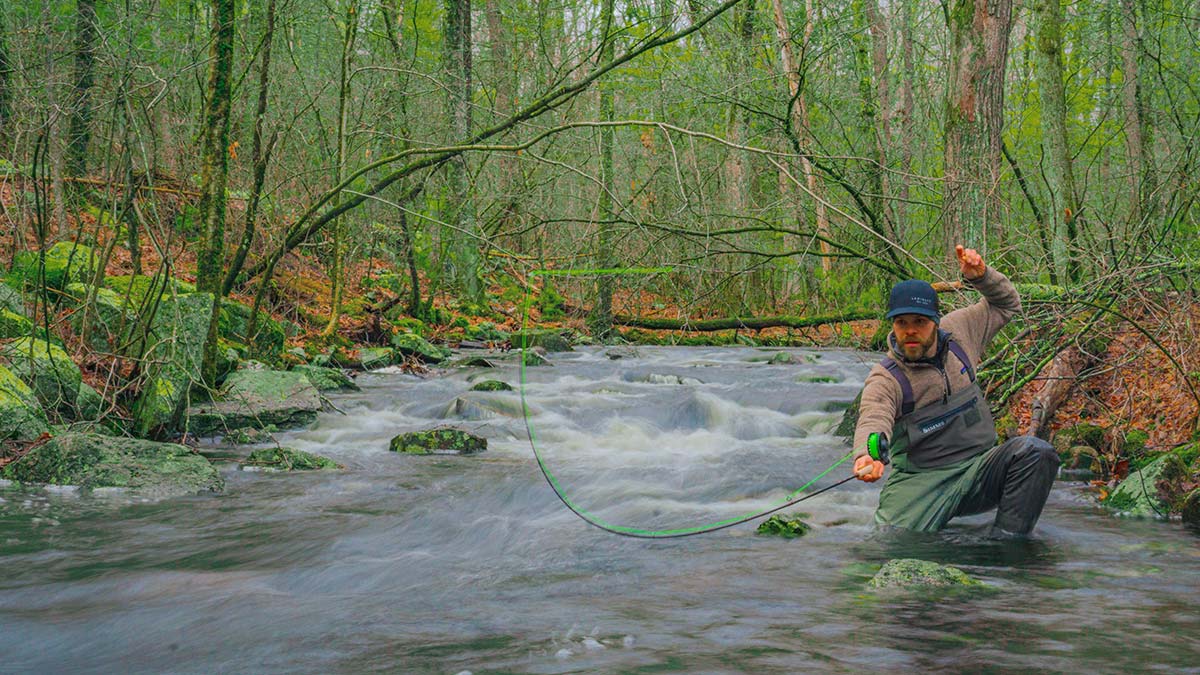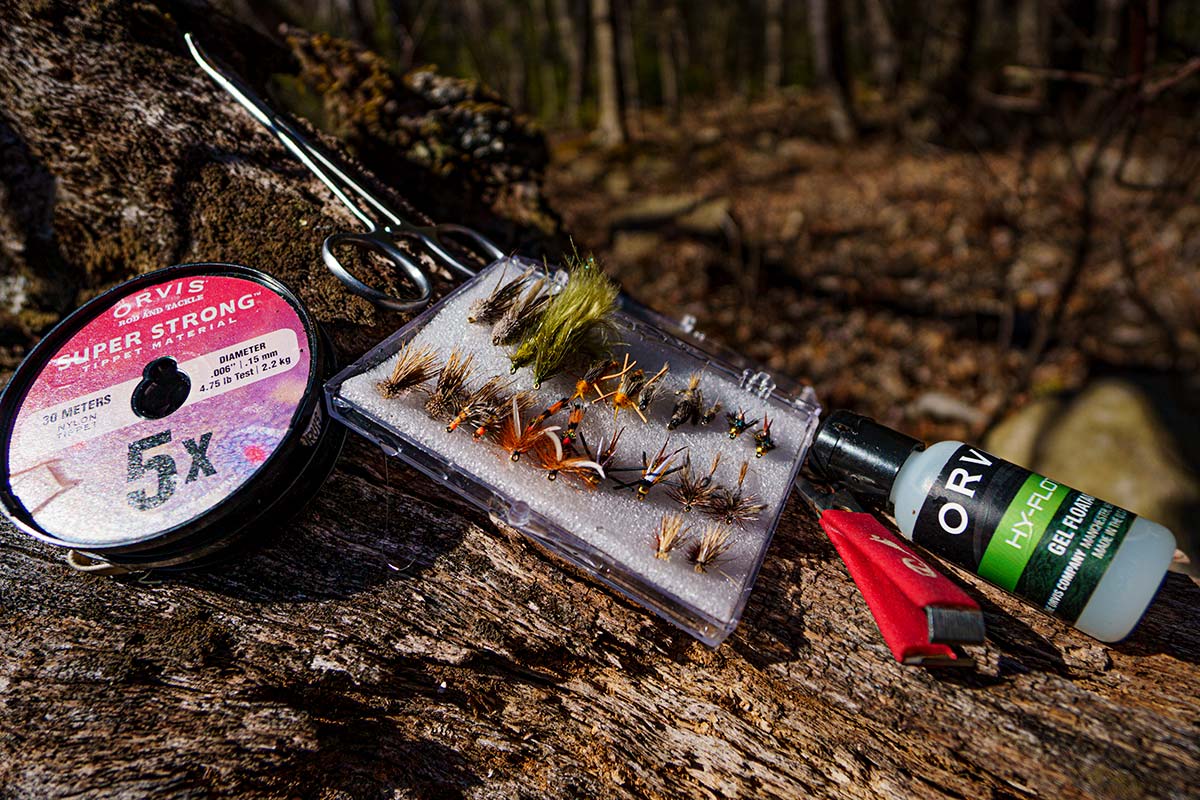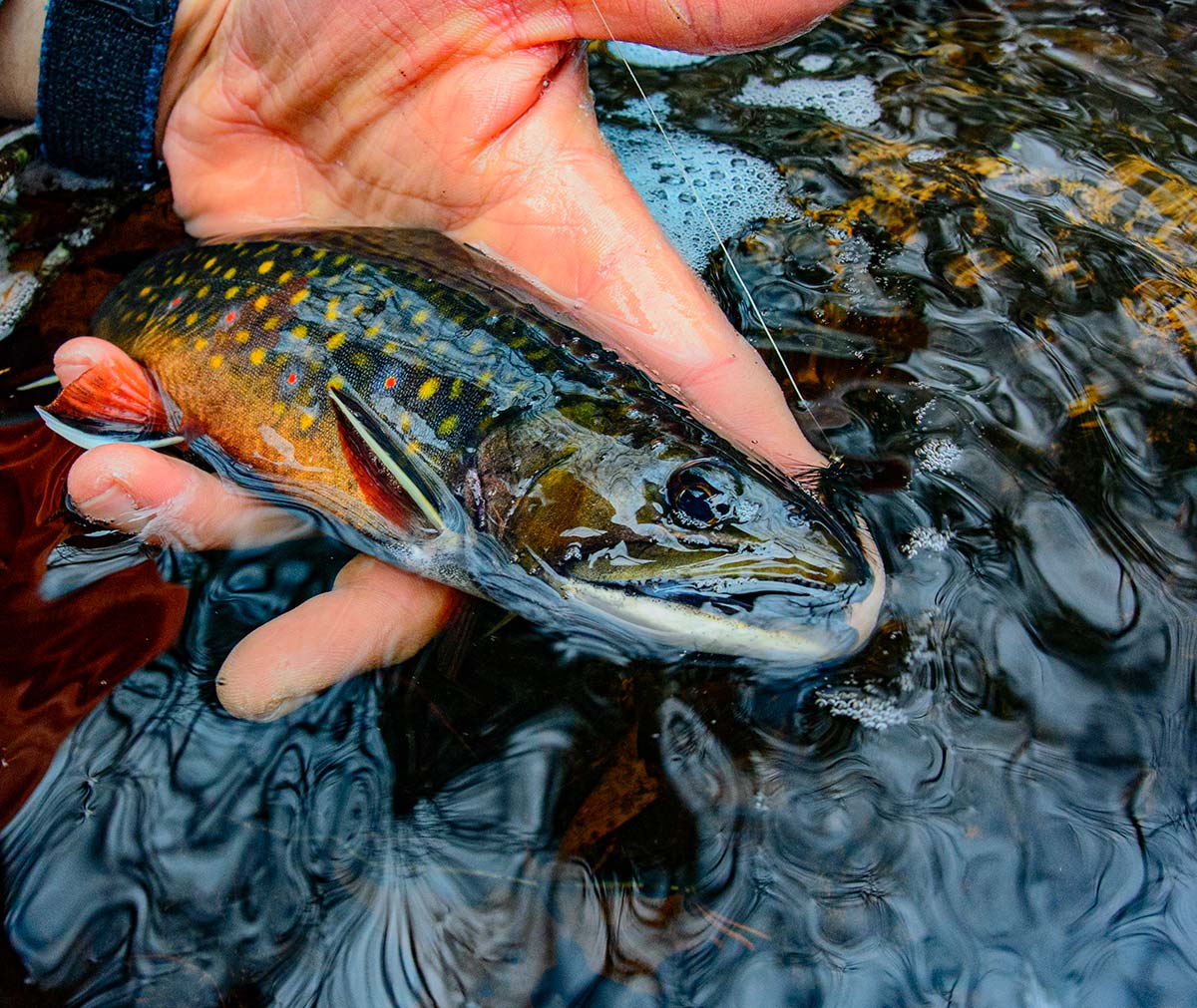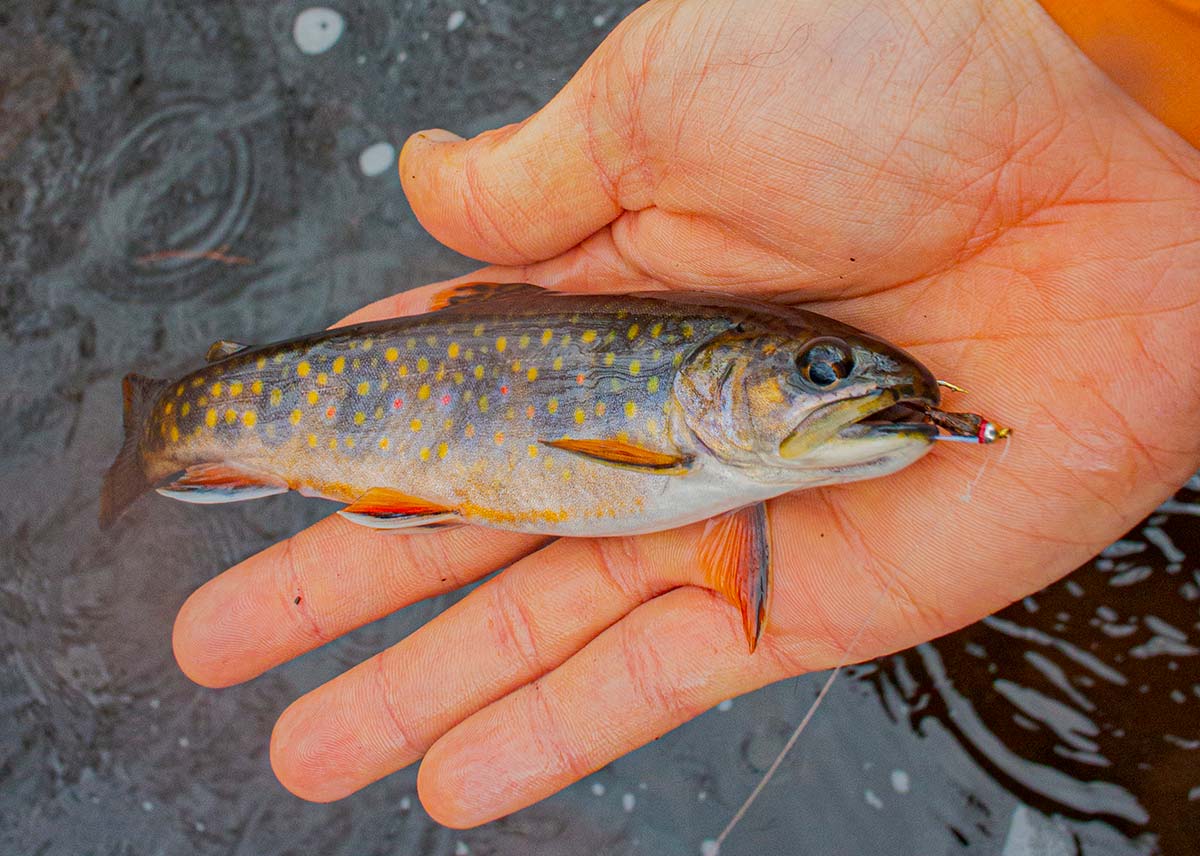
The month of May is a magical time to be a fisherman. As spring starts to slide into summer, angling opportunities abound in both fresh and salt ecosystems.
In May, no matter where you are in the vast region we call the Northeast, trout fishing is either heating up or hitting a peak. While I have fished for trout in virtually every size and type of water, small streams remain my favorite. These beautiful little places hold a special place in my heart, and May is one of my favorite months to fish them.
My love of small streams is a combination of the novelty of catching fish in such miniscule water ways, the connection it makes me feel to the remnants of wilderness that still hang-on in New England, and my nostalgia for the angling I used to do with my grandfather as a child. Further, finding a stream that actually has fish in it can feel like a very challenging scavenger hunt, and once found the native trout residing there aren’t always easy to catch. In combination, this makes for a richly rewarding experience I find difficult to replicate with other fisheries.
Finding Your Gem
If you’re new to small stream fishing, finding and fishing a tiny wild-trout haven can be daunting. I won’t deny that it takes a bit of research ahead of time, and more than a small amount of time on your feet exploring. I use satellite maps from Google Earth and a Delorme atlas to start, but these often do not provide enough information to really determine if a stream will sustain a population of trout. The best way to verify the viability of small stream, is to simply fish it. Taking the “risk” of spending a couple days surveying empty water will hopefully pay off in the long run, and I do believe there are some real gems out there yet to explore. In full disclosure, I think the number one way to find a miniscule wild trout stream is to already have an idea of what a good one looks like. This means having prior experience fishing these ecosystems. But to gain this experience, you have to have some kind of exposure; it’s a Catch-22 scenario, and a hurdle we all must get over. The only way to gain this experience is to fish and explore.
I have one simple piece of advice that will help; if you are determined to find your own native-trout haven, hunt for a stream in which the water stays cold throughout the year. These brooks are so tiny and shallow, they are subject to rapid and substantial temperature swings. Native trout cannot tolerate water over 70 degrees for very long, and they become unwilling to feed, stressed, and highly sensitive to release mortality. Therefore, when trying to determine if a blue-line on a map is a viable trout water, finding a stream that doesn’t get hot is the most critical component.

If the stream runs into or out of a larger river, pond, or lake, this can provide a thermal escape. Additionally, streams flowing out of larger water bodies can be supplied with a constant flow of cooler water. However, many streams still get too warm, particularly in southern New England. Therefore, if I’m not in Vermont or Maine, I hunt for streams that are both fed by springs and eventually make it into a larger body water. Sometimes these streams just start with a puddle, or sometimes even burst right out of the ground. The combination of cold water coming from up-stream, and an escape down-stream, has proven to be the ticket for me.
Since you may be hiking long distances, and fishing for tiny populations, it’s best to focus on places with the highest likelihood of success within a stream. I catch fish in all parts of my favorites, but I generally focus on the deepest pockets. This is, of course, highly relative: my favorite two brooks never top 6 feet deep, and I am guessing the average pool is less than 3 feet. The shallow riffles and runs are generally devoid of life, or contain only very tiny fish. I believe this is because there is nowhere for “larger” trout to hide, and because the streams are so small, it’s hard for these fish to escape if they are attacked by terrestrial or air born predators. They can’t charge quickly into a deeper pool, or under a cut bank; these places are too far away, or just don’t exist in much of the streams I fish.
Further, since the deeper pools aren’t actually all that deep, there is no need to dredge them with sinking lines, heavy flies, or other specialized gear. You can access the fish in these deep spots with the same flies and gear you would in any other portion of the stream. Therefore, particularly when you’re first starting out, I suggest hopping from deep spot to deep spot, and once you’re sure there are fish, you can start branching out into other sections. I will admit, breaking away from the pools is very rewarding, but may take several seasons to accomplish.
The Essential Gear
Now that you have a few ideas to get your started, you can begin checking off the gear you’ll need. First, ignore reel selection completely; if your reel fits on your rod and isn’t cumbersome, it’s good enough. You’ll never need drag, and you rarely (if ever) will see line go off your reel while fighting a fish. Therefore, focus on the rod and the line. To date, I have mostly used either a very inexpensive 6-foot, 2-weight or a 7-foot, 4-weight rod. However, I am very excited about my custom 6-1/2-foot glass 3-weight I just acquired for the coming season. It’s the perfect rod for this style of fishing! Whatever you currently have will work, but a low weight (1 to 4 weight), short rod (less than 7 feet) is best for brushy banks and small fish.
As with all forms of fly fishing, the line can make or break how a setup casts. I suggest budgeting for good line, even if it means having a slightly lower-model rod. Any high quality, properly tapered, weight-forward line will work. While you won’t be using a traditional overhead cast very often, having a good line allows your rod to be more versatile and adequate for waters where longer casts are required.

Counter intuitive as it is, I actually like a pretty aggressive head taper for my small stream setups. Since I rarely have more than 15 feet of line out, a 30-foot head is already pretty long. A delicate dry fly specific taper with a 45- or 60-foot head means only a third or quarter of my head-weight is available to cast. Especially when roll casting, or the rare times I’m actually doing a side arm or overhead cast, I want at least a modest amount of line weight in the air. For leader and tippet, I almost always just use a six-to-seven-foot trout leader and 5x tippet, for a total of seven- to eight-feet. Rarely, I will scale down to 6x, and I typically won’t even carry any other diameters of tippet.
I want all my gear to fit in the pocket of my waders; there is no need for a sling pouch, or even a bulky vest. A small fly box, tippet, an extra couple of leaders, forceps, line cutter, and floatant is all I carry. Don’t get bogged down in packing too much stuff; it becomes cumbersome, isn’t necessary, and having too many flies can actually become overwhelming.
Simply Filling The Fly Box
The vast majority of feed comes from terrestrial sources in these small places. This means the fish have to be ready and willing to eat anything that floats by. Therefore, fly selection matters a whole lot less than it does with large, fussy trout, sipping emergers, cripples, and duns from the surface. The trick in small streams is primarily to not spook the fish, and to present your fly in a natural, drag-less manner. If you do this, the fish will eat your fly at least 90% of the time.
Hence, my fly box for small streams remains very simple. The two flies I use the most are a bead-head Prince Nymph, and an Adams (usually an Adams Wulff). If I just had these two flies, I think I’d still catch almost all of the fish I catch yearly with all flies combined. In particular, I find the nymph works particularly well in the “deeper” pools and slow runs. The Adams imitates a huge variety of insects on top, and even when fish have been rising on miniscule midges, I’ve had them happily sip an Adams. I usually carry a spectrum of sizes in each of these flies, lest I run into a small or large species, but a #12 Prince and #14 Adams are my go-to.

The rest of my box is rounded out by a diverse, but small, spectrum of patterns. Many anglers adore the Elk Hair Caddis, and I feel relatively affectionate towards them as well. I also typically carry Royal Coachman and Light Cahill patterns. I believe they are varied enough from the Adams and Caddis to sometimes make a difference, especially the much lighter-colored Cahill. It also doesn’t hurt to have a few mosquito patterns; they are always abundant where I fish.
As for subsurface, in addition to the Prince Nymph, I like to have Ribbed Hare’s Ear and a Scud patterns. The Scud in particular has pulled fish out of pools when I felt nothing would work, and I feel a little superstitious about it; a green Scud is always in my box.
Finally, I won’t leave home without a few small wooly buggers. They catch every kind of fish, in every possible type of water. They also can sometimes be more tempting to larger fish—whopping 6- to 8-inchers—as they offer a more substantial meal in comparison to the other flies I’ve listed here. In the same vein, I like to have a San Juan or Wiggly worm, as they are excellent prospecting flies; they are considered cheating in some circles because they catch so well! If you are just starting out, this might be the fly to try first; it’ll almost always show you whether there are fish in the water you’re exploring.




